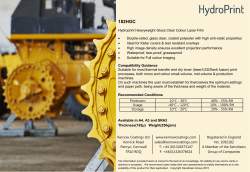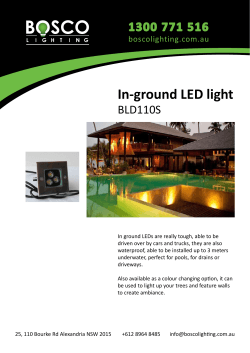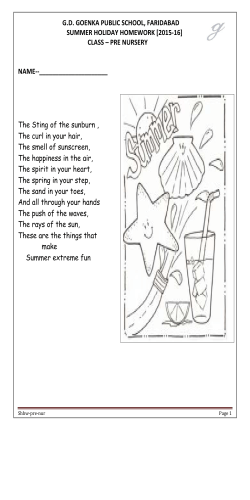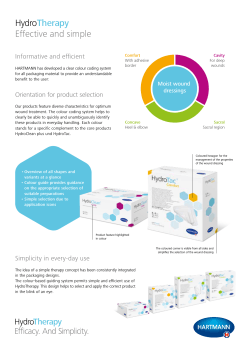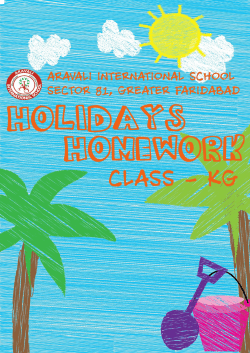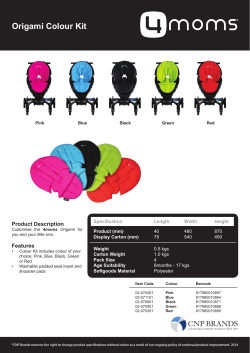
- Riverside Junior School
Riverside Junior School Nurture : Inspire : Challenge to develop Creativity : Love of Learning Project Brief : Excellence Overview of Approach Use bold text throughout this document to indicate those aspects which are required in order to comply with the new National Curriculum The fundamental aim of the Art & Design curriculum is to develop pupil’s artistic potential and aesthetic sensitivity and tactile elements of the world in which they live. All pupils should have opportunities to investigate ideas and materials. At KS2, pupils should be encouraged to participate in and enjoy an expanding range of art activities. These should enrich pupil’s sensory experiences, continue to develop imagination and creativity and promote pupil’s self-esteem and social skills. A high quality art and design education should engage, inspire and challenge pupils, equipping them with knowledge and skills to experiment, invent and create their own works of art, craft and design. Pupils should work individually, in groups and when appropriate as a whole class, They should begin to exercise choice in the selection of materials, tools and techniques for recording their observations and expressing their ideas and feelings. Pupils need to become proficient in drawing, painting, sculpture and other art, craft and design techniques. They should be given opportunities to evaluate and analyse creative works using the language of art, craft and design and to know about great artists, craft makers and designers. They should also understand the historical and cultural development of art forms. How we will ensure that the approach taken to subject: Reflects and reinforces Riverside’s vision and values Supports the goal of ensuring outstanding learning for all By complying to the Art Policy and Riverside’s Art Scheme Of Work coverage of all of the above will ensue. The Scheme of work provides a rolling programme to cover skills. It outlines the specific historical aspects and architectural elements to be studied by each year group so that repetition does not occur but covers a broad spectrum linked to historical and cultural developments. We will continue to optimise all opportunities for community links both locally and nationally to enhance the quality of our teaching. We will continue and build on the success of the ‘Take One Picture’ project. (Themed cross –curricular arts project). We will build on the success of the Arts Award Scheme. We will strive to achieve the Artsmark Award over the next year. Riverside Junior School Nurture : Inspire : Challenge to develop Creativity : Love of Learning Project Brief : Excellence SCHEME OF WORK SUBJECT OVERVIEW The order and sequencing of the units of the work will depend on curricular topics and the texts studied in English. All the required Art History/Skills prog./Architecture will be covered by the end of the year. Year 3 Autumn Spring Summer History Realism 1850’s Impressionism 1870’s Neo Impressionism 1880. Post Impressionism 1880. Fauvism 1900’s Multi-cultural art. Architecture/Architects. Philip Johnson 1908 Zaha Hadid 1950 Walter Grapius (Bauhaus) optional. Basic design-dot, line,shape/form and pattern. Shading techniques- how to hold and use pencils ( hard HB- soft 4B) and pencil crayons. Painting techniques- how to use different sized brushes, how to mix different paints, paint consistency and its effec Objective studies-singular and group; charcoal, pencil pastel/chalk and pen. Figurative work- portraits and profiles; charcoal, pencil, pastel and paint. Colour work- shades of one colour; block and patterns. Primary and secondary colour exercises. Black and white patterns and compositions. Insight into the colour wheel. Composition- emphasis on selection of image, colour and texture. 3D- plasticine, collage, papier-mache, modelling clay. Ceramics; pinch and coil pots. Riverside Junior School Nurture : Inspire : Challenge to develop Creativity : Love of Learning Project Brief : Excellence Graphics- calligraphic variations. Textiles- printing and tie dye. ICT- Paint options and research on specific artists, architects and designers. + Cross curricular topics. 4 History Expressionism 1900’s Cubism-1906-1950. Futurism 1909-1914. Multi-cultural art. Architecture/Architects. Frank Gehry 1929. Renzo Piano 1937. Friedensreich Hundertwasser 1928. optional Basic design- dot, line,shape/form, pattern .and texture Shading techniques- using a range of hard HB- soft 4B pencils and pencil crayons. Painting techniques- improved brush control. Colour mixing. Paint consistency and its effects. Objective studies-singular /close up; enlargements. Grouped objects in simple backgrounds. More emphasis on lig and dark tones. Figurative work- portraits and full figures; charcoal, pencil, pen chalk and pastels. Colour work- shades of one colour compositions. Revision of primary and secondary colours. Revision of black and white. Descriptive colour (actual colour sizes). Composition- incorporating selection of image, colour and texture. Emphasis on focal points ( centre of interest; lea Riverside Junior School Nurture : Inspire : Challenge to develop Creativity : Love of Learning Project Brief : Excellence eye into the picture). 3D- collage, papier-mache, modelling to designs, mixed media and clay. Ceramics; coil and slab pots. Graphics- introduce calligraphy and simple poster designs. Emphasis on scale, format and colour. Textiles- printing and tie dye. ICT- paint /design options. Research on artists, architects and designers. + Cross curricular topics. 5 History. Abstract Art 1914. Dada 1916. Constructivism 1917 Surrealism 1920. Architecture/ Architects. Antoni Gaudi 1852 optional Ludwig Mies Van der Roche 1886. Moshe Safdie 1938. Jean Nouvel 1945. Basic Design- dot, line, shape/form, pattern and texture. Shading and Painting Techniques- refer to Yr.3 programme. Objective studies- singular and group studies incorporating imagery reflected in/on objects especially on close ups. Figurative studies- portraits, full figure, groups of people. More variation in poses incorporating finer detail in pencil chalk, pastels and paint. Colour work- As Year 3 and 4 revised plus the introduction of Complementary colours (colours at their most brilliant Symbolic colours within compositions ( red-danger, green-go). Riverside Junior School Nurture : Inspire : Challenge to develop Creativity : Love of Learning Project Brief : Excellence Composition-Incorporate selection of image, colour, texture, focal points but emphasis on balance and movement ( conformity, symmetry or imbalance and asymmetrical backgrounds to capture movement). 3D- collage, papier-mache, modelling to detailed designs with mixed media. Ceramics; coiled and moulded pots. Graphics- varied calligraphy, specific poster designs. Focus on format, font, scale and colour. Textiles- printing and batik. ICT- Paint and graphics work. Research work for artists, architects and designers. + Cross curricular topics 6 History. Abstract Expressionism 1945/50’s Op & Pop Art. Diversity 1970’s Primitive Art & Primitivism 1800 to date. Multi-Cultural Art. Architecture/Architects. Frank Lloyd Wright 1867 Leoh Ming Pei ( IM Pei) 1917 Tom Wright 1957. Modern architecture… 1960’s onwards. Optional. Basic Design- dot, line, shape/form, pattern and texture. Shading & Painting Techniques- Refer to Yr.3 programme. Objective studies- As Yr. 3-5 with emphasis on a consideration of balance, space, pattern and contrast using mixed mediums selected by the pupil. Riverside Junior School Nurture : Inspire : Challenge to develop Creativity : Love of Learning Project Brief : Excellence Figurative studies- As Yr.3-5 revised with emphasis on conveying texture through a variety of mediums selected by pupil. Colour work- As Yr 3-5 revised plus the introduction of ‘Advancing and Receding colours’ to create depth and ‘Decorative colour’ chosen to create a specific mood and feel. Composition- Incorporate selection; image, colour, texture, focal points, balance & movement. Introduce ‘Space an pattern’ and ‘Contrast & harmony.’ Renaissance artists used depth and distance to convey perspective. 3D- Pupils to select a suitable medium to work in for a given assignment and to be conscious of scale. Ceramics; modelling, pinch, coil and/or slab pots. Graphics- Knowledge of lettering to be conveyed by pupils in their work. Consideration given to colour and scale an appropriateness to the task. Textiles- printing, tie dye, batik. Fashion designs. ICT- Graphics, paint and design programmes. Research work for artists, architects and designers. + Cross curricular topics. All Language & Communication - to be introduced , explained and used regularly within art lessons. Basic design- dot, line, tone, shape, form, scale, proportion, colour, pattern, texture…shade; dark, light, hard, soft. Colour- primary, secondary, complementary, descriptive, decorative, symbolic, opposites, spectrum, recede, advanc camouflage, opaque, transparent, thick, thin, watery, warm, hot, cool, cold. Actions- draw, write, paint, brush, dab, daub, mix, stipple, sprinkle, splash, blow, roll, stamp, smudge, smear, smoot build, remove. Types of work- drawing, painting, modelling, objective, imaginative , abstract, design, portrait, profile, figure work, landscapes, graphics, kinetic, textile, construction, printmaking, collage, montage, ceramic, sculpture, carving, printin Riverside Junior School Nurture : Inspire : Challenge to develop Creativity : Love of Learning Project Brief : Excellence photography, batik, tie dye, puppetry… Composition- selection, focal point, balance, movement, space, pattern, contrast, harmony. Riverside Junior School Nurture : Inspire : Challenge to develop Creativity : Love of Learning Project Brief : Excellence Scheme/Block of Work (medium term plan) template Title of scheme (eg, Creative Writing / Persuasive writing / a literary text) Year/class: year group/ designation Dates (from….to……..) Number of lessons: Objectives to be addressed in whole scheme NC English or cross curricular PSHE etc/ Framework/ Exam syllabus Learning outcomes from the scheme/block Work which pupils will produce. This is likely to be all the work that you will assess, so include oral work as well as written. Should identify, in broad terms, how work will be differentiated according to ability. Riverside Junior School Nurture : Inspire : Challenge to develop Creativity : Love Project of Learning : Excellence Brief Lesson no. 1. Key Nat.Curr./ Framework /exam syllabus references; 2. Learning Outcomes 1. Refs: 2. Outcomes: Specific learning objectives (LOb) (use dynamic verb; link to NC English or cross curricular PSHE etc/ Framework/ Exam syllabus) Brief outline of lesson content & teaching / learning activities Resources; uses of ICT, if available Assessment: how will you know whether pupils have met the LObs? (e.g., observation & recording; marking written or oral work…)
© Copyright 2026
